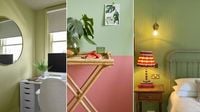As the housing market continues to evolve, America’s home builders are shifting their priorities to better align with the changing preferences of today’s home buyers. The pandemic significantly influenced these preferences, prompting builders to increase square footage in new homes as families spent more time indoors. However, recent trends indicate a reversal, driven largely by concerns over housing affordability.
According to the latest data from the U.S. Census Bureau and an analysis by the National Association of Home Builders (NAHB), the median size of single-family homes has decreased. In the third quarter of 2022, the median single-family floor area fell to 2,276 square feet, down from 2,326 square feet during the same period in 2021. This marks a notable shift in the market, as the pandemic had previously led to a surge in demand for larger living spaces.
Moreover, the composition of new homes is also changing. Only 9.2% of new single-family homes are now being built with two bedrooms or fewer. In contrast, nearly half (44%) feature three bedrooms, and more than a third (36%) include four bedrooms. This trend reflects a growing demand for more functional living spaces, with 2021 marking the second consecutive year that the share of four-bedroom homes has increased.
Additionally, the trend towards more bathrooms in new homes continues. A majority (62%) of new single-family homes now come equipped with two full bathrooms, a figure that has remained consistent since 2005. Notably, 93% of homes measuring 5,000 square feet or more boast three or more full bathrooms, catering to families looking for convenience and comfort.
Outdoor living spaces are also evolving, with homeowners increasingly favoring patios over decks. For the sixth year in a row, the share of new homes featuring patios has risen, while the popularity of decks has declined. However, in regions like New England, more than half (60%) of new homes still include decks, indicating regional preferences in outdoor design.
Another interesting trend is the declining interest in two-story foyers. The share of new homes with this feature dropped from 29% to 25% in 2021, marking the lowest level in five years. Many home buyers have deemed two-story foyers energy inefficient, leading to their decreased popularity.
As home builders adapt to these shifting preferences, they are also responding to a growing desire for aesthetic appeal. One of the standout trends emerging for 2025 is the pistachio green color, which is gaining popularity in home interiors. This soft, muted green with subtle yellow undertones is being hailed as one of the biggest interior paint color trends currently.
Interior designer Paulina Wojas describes pistachio green as a versatile hue that complements various design aesthetics. “Pistachio green is a muted version of green that has an earthy tone that complements a nature-inspired aesthetic and is perfect for a refreshing and relaxing space,” she explains. The adaptability of this color makes it suitable for homes of all sizes.
For those looking to incorporate this trend into their homes, several strategies can be employed. Starting with accent accessories is a great way to test the waters. Items like rugs, cushions, and decorative accessories can introduce the color without committing to larger changes. Arti Popat, an interior designer, suggests that these smaller items can enhance the tactile and comforting benefits of the hue.
Wallpaper is another effective method to bring pistachio green into a space. Jamie Watkins, co-founder of Divine Savages, recommends using wallpaper to add texture and personality. Pairing it with warm neutrals and rich textures can enhance its vintage-meets-modern charm. For those hesitant about a full wall, a floral print featuring pops of pistachio can offer a softer introduction to the color.
For the more adventurous, color drenching—painting walls, ceilings, and woodwork in pistachio—creates a serene, immersive feel. Michael Rolland, managing director of The Paint Shed, notes that this technique is particularly effective for contemporary spaces, allowing homeowners to move away from neutrals and introduce more vibrant colors.
Pistachio green furniture can also make a striking statement. Whether painting existing pieces or investing in new ones, this color can transform a room. Twan Verdonck, creative director at Brabantia, suggests using this shade in kitchen cabinetry for a timeless appeal.
For those new to color, a partial approach, such as an accent wall, can provide a less overwhelming introduction. Victoria Yardley recommends painting the wall behind a bed in pistachio to uplift the space without overpowering it.
Bathrooms are another area where pistachio green can shine, offering a calming, spa-like atmosphere when paired with natural textures. Accessories like towels and bath mats in this hue can refresh the space without major renovations.
Complementary colors play a significant role in enhancing the pistachio trend. Warm earthy tones like terracotta can create a sun-kissed Mediterranean vibe, while a splash of coral or dusky pink can add vibrancy. For a more subdued palette, pairing pistachio with light creams or mid-greys can create a harmonious look.
In smaller spaces, pistachio green can create an airy feel, making rooms appear larger. Using lighter finishes and pairing with soft neutrals can maintain openness while adding character.
Focusing on woodwork is another subtle way to incorporate pistachio green. Painting skirting boards and window trims can enliven neutral color palettes without overwhelming the space.
Finally, pistachio green can extend outdoors, making it a popular choice for garden furniture and accessories. Its natural connection complements greenery beautifully, allowing homeowners to create a serene outdoor environment.
As 2025 approaches, the trends in home building and interior design reflect a broader shift towards affordability, functionality, and aesthetic appeal. Builders are adapting to the needs of modern home buyers while color trends like pistachio green are redefining the way we think about our living spaces.



